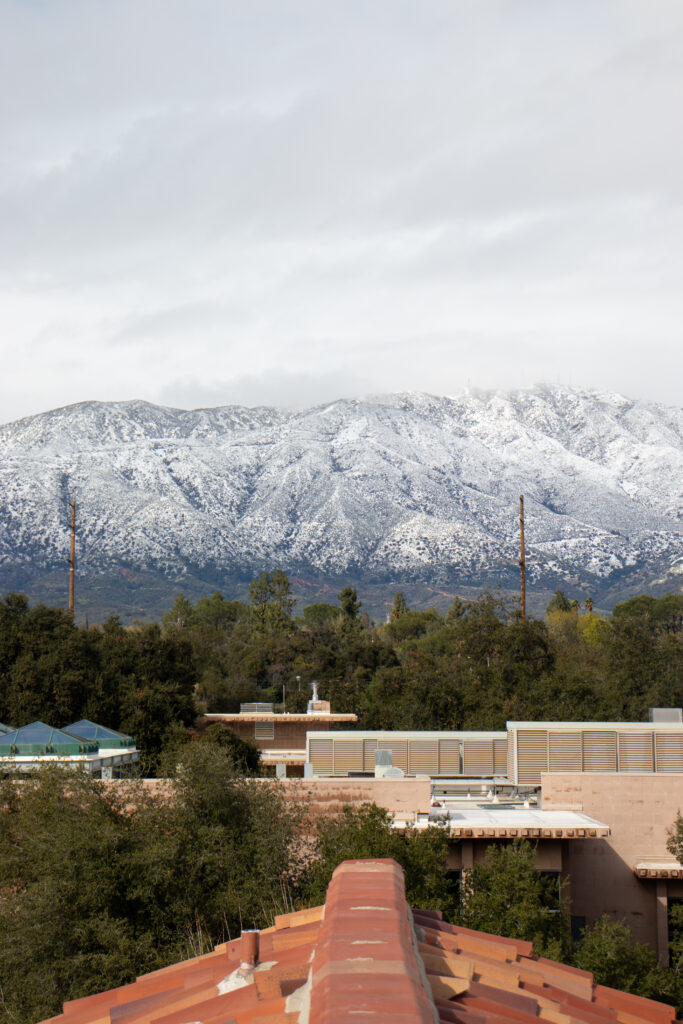Ellen Hu ’24
Editor-in-Chief
When one of Eliza Kornfeld’s ’23 professors brought up the prospect of snow in Claremont, she and her classmates doubted it would actually happen. She had been keeping an eye on the news and expected rain, but the prospect of snow seemed far-fetched.
“Wait, what? That’s insane!” Kornfeld said. “That’s what I was thinking because I didn’t understand how we could get snow at such a low elevation.”
A low-pressure system hit Southern California in late February, resulting in cold temperatures as well as a large magnitude of hail, rain, and snowfall that began on Feb. 24. The San Bernardino Mountains were covered in about 10 feet of snow while other regions of Southern California received between three-10 inches of rain as of Feb. 26.
Claremont received approximately 4.6 inches of rain during this time. Short periods of snowfall occurred on Feb. 25 and March 1 as well.
The intensity of the storm was unexpected to some. “I was somewhat looking forward to the rain, especially as someone who lives in Southern California, but I was definitely not expecting it to be that cold,” Isabel Li ’25 said.
The storm impacted the daily lives of several Scripps students. Natalie Burton ’24 lives at the Claremont Colleges Apartments (CCA), approximately a 20 minute walk from the center of the Scripps campus. The heavy rains forced them to re-adjust their schedule while commuting between their housing and classes.
“I typically walk to and from my apartment to campus,” Burton said. “Because of the storm, I’ve been taking the shuttle more often, but it’s not the most convenient to plan my schedule around that. On days where it was only predicted to rain in the morning or evening, I carried a coat and umbrella around with me all day, which, again, was not the most convenient thing to do.”
Other students experienced similar challenges. “The main inconvenience of the storm was that I couldn’t ride my bike without getting absolutely soaked,” Li said. “I have orchestra at Pomona twice a week, and even more that week due to concerts on the weekends, so it was not fun walking in the cold and getting my shoes all drenched.”
Despite the weather’s inconvenience, Kornfeld and her friends followed through with an off-campus trip on the weekend of Feb. 25. “During the worst of the storm on Feb. 24, my friends and I drove in the torrential rain and spent all day at Universal Studios,” she said.
She acknowledged that the intensity of the weather made it a difficult decision to make, but the group followed through with their trip in the safest way possible. While they were able to make the trip without incident, Kornfeld and her friends witnessed heavy rainfall’s impact on the roads firsthand. “The rain did not stop for even a second and we passed multiple car crashes as we drove back to Claremont,” she said.
Nonetheless, the negative impacts of the precipitation didn’t stop students from appreciating this change from the usually dry environment. “I love the rain, so these small annoyances were worth it!” Burton said.
The snowfall added a different level of excitement to the storm. “My friends and I were just starting our drive to San Diego when it began snowing,” Kornfeld said. “We could barely see it at first but then it really started coming down and we all got so excited! Everyone was taking photos and videos and FaceTiming each other.”
Other students on campus, such as Burton, made sure to document the experience. “ I was walking to class when it started snowing on Wednesday,” they said. “I stopped to take a bunch of photos to send to my family.”
At the same time, the snow brought up questions of climate change for many. For some, it made the climate crisis a lot more real. “It was…interesting (intellectually at least) to experience climate whiplash firsthand in a major way,” Burton said.
“It was exciting but also very strange,” Kornfeld said. “It certainly sparked conversations about climate change and global warming.”
While Kornfeld had these conversations with her friends, it was not a conversation she found in the classroom setting. “It would have been nice if we did,” she said.
Image Source: Louisa Calhoon ’24



